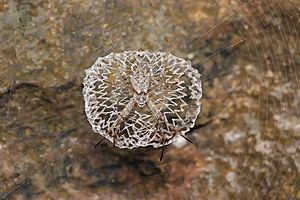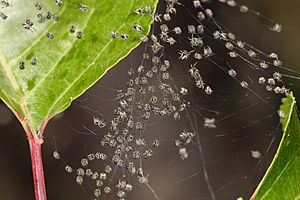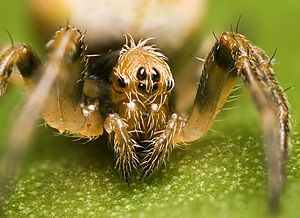Orb-weaver spider facts for kids
Quick facts for kids Orb-weaver spiders |
|
|---|---|
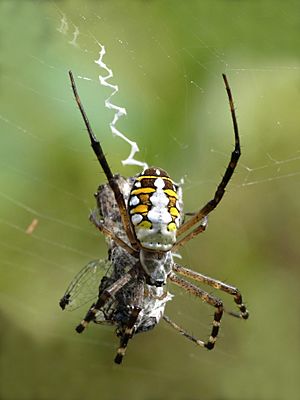 |
|
| Argiope catenulata | |
| Scientific classification |
|
| Kingdom: | Animalia |
| Phylum: | Arthropoda |
| Subphylum: | Chelicerata |
| Class: | Arachnida |
| Order: | Araneae |
| Infraorder: | Araneomorphae |
| Superfamily: | Araneoidea |
| Family: | Araneidae Clerck, 1757 |
| Diversity | |
| 175 genera, 3058 species | |
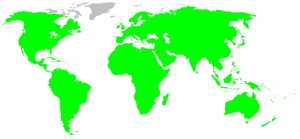 |
|
Orb-weaver spiders are a big family of spiders called Araneidae. They are famous for building amazing spiral, wheel-shaped webs. You can often find these webs in gardens, fields, and forests. The word "orb" means "circular," which is why they are called orb-weavers.
These spiders have eight eyes that look similar. Their legs are often hairy or spiny. Orb-weavers are found all over the world. Many of them are large or have bright colors, like the garden spiders you might see.
The Araneidae family is the third-largest spider family. It has over 3,000 different kinds of spiders in more than 170 groups. Orb-weaver spiders build their webs in a very specific way. First, they create a frame of silk that isn't sticky. Then, they add a spiral of silk covered in tiny, sticky drops. This sticky silk is what catches insects.
Other spider families also make orb-shaped webs. For example, long-jawed orb weavers are related to Araneidae. Another group, the hackled orb-weavers, make similar webs. But they use a different kind of silk that is not sticky.
Contents
Amazing Orb-Weaver Spider Webs
Orb-weaving spiders usually have three claws. They use these claws to build flat webs with sticky silk. Building a web is like a big engineering project!
Here is how they do it:
- The spider first lets a silk line float on the wind. This line connects to another surface, like a branch.
- The spider secures this first line. Then, it drops another line from the middle, making a "Y" shape.
- Next, the spider builds the rest of the web's frame. It adds many non-sticky lines that spread out like spokes on a wheel.
- Finally, the spider adds a sticky spiral of silk. This is the part that traps insects.
The spider uses its third claw to walk on the non-sticky parts of the web. When an insect flies into the sticky lines, the spider quickly bites it. This bite stuns the prey. Then, the spider wraps the insect in silk. If the insect is dangerous, like a wasp, the spider might wrap it first before biting.
For the web to work well, it needs to be hard for insects to see. But the stickier the web, the more visible it can be. So, spiders have to find a balance between being sticky and being hidden.
Many orb-weavers build a new web every single day. Most of them are active in the evening. They hide during the day. As evening comes, the spider often eats its old web. After resting for about an hour, it spins a brand new web in the same spot. This means their webs are usually very clean.
Spiders That Don't Build Webs
Some orb-weavers don't build webs at all! Spiders in the Mastophora group (in the Americas) and Cladomelea (in Africa) are examples. They make sticky balls that smell like insect pheromones. A pheromone is a chemical signal that animals use to communicate.
The spider dangles this sticky ball from a silk thread. The smell attracts male moths of certain species. The moths get stuck on the ball, and the spider pulls them in to eat. These "bolas spiders" are very good at hiding.
Spiny orb-weaving spiders, like those in the Gasteracantha and Micrathena groups, look like plant seeds or thorns. They hang in their orb-webs. Some Gasteracantha species have very long, horn-like spines on their bodies.
Web Decorations: Stabilimentum
Some orb-weavers add a special crisscross silk band to the center of their webs. This is called a stabilimentum. You can see it in spiders like Argiope, also known as yellow and banded garden spiders.
Scientists think the stabilimentum might have a few uses:
- It could attract prey.
- It might warn birds to stay away from the web.
- It could help the spider hide when it sits in the middle of the web.
- It might make the silk less visible to insects.
The silk used by orb-weavers is super strong. It can handle the impact of flying insects. Some orb-weavers, like Zygiella x-notata, build webs with a unique missing section.
Ancient Orb-Weavers
Fossils show that orb webs existed a very long time ago, during the Cretaceous period. This was about 140 million years ago! At that time, many flowering plants and insects were also appearing. Orb-weavers became very important predators of flying insects in many places. Some scientists even think that spider predation, especially by orb-weavers, helped drive the evolution of insects.
Most spider webs are built vertically, and the spiders usually hang upside down. Some orb-weavers, like those in the Metepeira group, hide their orb web inside a tangled mess of other silk. Some Metepeira spiders even live together in huge communal webs. In 2009, workers at a treatment plant in Baltimore found a giant web covering four acres! It had over 100 million orb-weaver spiders living in it.
Reproduction and Life Cycle
Orb-weaver spiders have interesting ways of mating.
- Sometimes, the male spider slowly walks to the center of the female's web. He has to be careful not to get eaten! Once he reaches the center, he grabs the female.
- Other times, the male builds a special mating thread near or on the web. He uses vibrations to attract the female. If she is interested, they mate on this thread.
Genera
As of April 2019, the World Spider Catalog lists many different groups (genera) of orb-weaver spiders. Here are some of them:
- Acacesia — Found in North and South America
- Acantharachne — Found in Africa
- Acanthepeira — Found in North America and Brazil
- Acroaspis — Found in New Zealand and Australia
- Acrosomoides — Found in Madagascar and Cameroon
- Actinacantha — Found in Indonesia
- Actinosoma — Found in Colombia and Argentina
- Aculepeira — Found in many parts of the world
- Acusilas — Found in Asia
- Aethriscus — Found in Congo
- Aethrodiscus — Found in Central Africa
- Aetrocantha — Found in Central Africa
- Afracantha — Found in Africa
- Agalenatea — Found in Ethiopia and Asia
- Alenatea — Found in Asia
- Allocyclosa — Found in the United States, Panama, Cuba
- Alpaida — Found in Central and South America
- Amazonepeira — Found in South America
- Anepsion — Found in Oceania and Asia
- Arachnura — Found in Asia, Oceania, Africa
- Araneus — Found worldwide
- Araniella — Found in Asia
- Aranoethra — Found in Africa
- Argiope — Found worldwide
- Artifex — Found in Australia
- Artonis — Found in Myanmar, Ethiopia
- Aspidolasius — Found in South America
- Augusta — Found in Madagascar
- Austracantha — Found in Australia
- Backobourkia — Found in Australia, New Zealand
- Bertrana — Found in South and Central America
- Caerostris — Found in Africa, Asia
- Carepalxis — Found in Oceania, South America, Mexico
- Celaenia — Found in Australia, New Zealand
- Cercidia — Found in Russia, Kazakhstan, India
- Chorizopes — Found in Asia, Madagascar
- Chorizopesoides — Found in China, Vietnam
- Cladomelea — Found in South Africa, Congo
- Clitaetra — Found in Africa, Sri Lanka
- Cnodalia — Found in Indonesia, Japan
- Coelossia — Found in Sierra Leone, Mauritius, Madagascar
- Colaranea — Found in New Zealand
- Collina — Found in Australia
- Colphepeira — Found in the United States, Mexico
- Cryptaranea — Found in New Zealand
- Cyclosa — Found worldwide
- Cyphalonotus — Found in Asia, Africa
- Cyrtarachne — Found in Asia, Africa, Oceania
- Cyrtobill — Found in Australia
- Cyrtophora — Found worldwide
- Deione — Found in Myanmar
- Deliochus — Found in Australia, Papua New Guinea
- Dolophones — Found in Australia, Indonesia
- Dubiepeira — Found in South America
- Edricus — Found in Mexico, Panama, Ecuador
- Enacrosoma — Found in South and Central America, Mexico
- Encyosaccus — Found in South America
- Epeiroides — Found in Costa Rica, Brazil
- Eriophora — Found in Oceania, United States, South and Central America, Africa
- Eriovixia — Found in Asia, Papua New Guinea, Africa
- Eustacesia — Found in French Guiana
- Eustala — Found in North, Central, and South America
- Exechocentrus — Found in Madagascar
- Faradja — Found in Congo
- Friula — Found in Indonesia
- Galaporella — Found in Ecuador
- Gasteracantha — Found worldwide
- Gastroxya — Found in Africa
- Gea — Found worldwide
- Gibbaranea — Found in Asia, Europe, Algeria
- Glyptogona — Found in Sri Lanka, Italy, Israel
- Gnolus — Found in Chile, Argentina
- Herennia — Found in Asia, Oceania
- Heterognatha — Found in Chile
- Heurodes — Found in Asia, Australia
- Hingstepeira — Found in South America
- Hypognatha — Found in South and Central America, Mexico
- Hypsacantha — Found in Africa
- Hypsosinga — Found in Asia, North America, Greenland, Africa
- Ideocaira — Found in South Africa
- Isoxya — Found in Africa, Yemen
- Kaira — Found in North and South America
- Kapogea — Found in Mexico, South and Central America
- Kilima — Found in Congo, Seychelles, Yemen
- Larinia — Found worldwide
- Lariniaria — Found in Asia
- Larinioides — Found in Asia
- Lariniophora — Found in Australia
- Leviellus — Found in Asia, France
- Lewisepeira — Found in Panama, Mexico, Jamaica
- Lipocrea — Found in Asia, Europe
- Macracantha — Found in India, China, Indonesia
- Madacantha — Found in Madagascar
- Mahembea — Found in Central and East Africa
- Mangora — Found in Asia, North, Central, and South America
- Manogea — Found in South and Central America, Mexico
- Mastophora — Found in North, Central, and South America
- Mecynogea — Found in North and South America
- Megaraneus — Found in Africa
- Melychiopharis — Found in Brazil
- Metazygia — Found in North, Central, and South America
- Metepeira — Found in North, Central, and South America
- Micrathena — Found in North, Central, and South America
- Micrepeira — Found in South America, Costa Rica
- Micropoltys — Found in Papua New Guinea, Australia
- Milonia — Found in Singapore, Indonesia, Myanmar
- Molinaranea — Found in Chile, Argentina
- Nemoscolus — Found in Africa
- Nemosinga — Found in Tanzania
- Nemospiza — Found in South Africa
- Neogea — Found in Papua New Guinea, India, Indonesia
- Neoscona — Found worldwide
- Nephila — Found in Asia, Oceania, United States, Africa, South America
- Nephilengys — Found in Asia, Oceania
- Nephilingis — Found in South America, Africa
- Nicolepeira — Found in Chile
- Novakiella — Found in Australia, New Zealand
- Novaranea — Found in Australia, New Zealand
- Nuctenea — Found in Algeria, Asia
- Oarces — Found in Brazil, Chile, Argentina
- Ocrepeira — Found in North, Central, and South America
- Ordgarius — Found in Asia, Oceania
- Paralarinia — Found in Congo, South Africa
- Paraplectana — Found in Asia, Africa
- Paraplectanoides — Found in Australia
- Pararaneus — Found in Madagascar
- Parawixia — Found in Mexico, South America, Asia
PNG, Central America
- Parmatergus — Found in Madagascar
- Pasilobus — Found in Africa, Asia
- Perilla — Found in Myanmar, Vietnam, Malaysia
- Pherenice — Found in Cameroon
- Phonognatha — Found in Australia
- Pitharatus — Found in Malaysia, Indonesia
- Plebs — Found in Oceania, Asia
- Poecilarcys — Found in Tunisia
- Poecilopachys — Found in Oceania
- Poltys — Found in Asia, Africa, Oceania
- Porcataraneus — Found in India, China
- Pozonia — Found in Caribbean, Paraguay, Mexico, Panama
- Prasonica — Found in Africa, Asia, Oceania
- Prasonicella — Found in Madagascar, Seychelles
- Pronoides — Found in Asia
- Pronous — Found in Malaysia, Mexico, Central and South America, Madagascar
- Pseudartonis — Found in Africa
- Pseudopsyllo — Found in Cameroon
- Psyllo — Found in Cameroon, Congo
- Pycnacantha — Found in Africa
- Rubrepeira — Found in Mexico, Brazil
- Scoloderus — Found in Belize, North America, Argentina
- Sedasta — Found in West Africa
- Singa — Found in Africa, Asia, North America, Europe
- Singafrotypa — Found in Africa
- Siwa — Found in Asia
- Spilasma — Found in South America, Honduras
- Spinepeira — Found in Peru
- Spintharidius — Found in South America, Cuba
- Taczanowskia — Found in Mexico, South America
- Talthybia — Found in China, Myanmar
- Tatepeira — Found in South America, Honduras
- Telaprocera — Found in Australia
- Testudinaria — Found in South America, Panama
- Thelacantha — Found in Madagascar, Asia, Australia
- Thorellina — Found in Myanmar, Papua New Guinea
- Togacantha — Found in Africa
- Umbonata — Found in Tanzania
- Ursa — Found in Asia, South America, South Africa
- Verrucosa — Found in North America, Panama, South America, Australia
- Wagneriana — Found in North, Central, and South America
- Witica — Found in Cuba, Mexico, Peru
- Wixia — Found in Brazil, Guyana, Bolivia
- Xylethrus — Found in South America, Mexico, Jamaica, Panama
- Yaginumia — Found in Asia
- Zealaranea — Found in New Zealand
- Zilla — Found in Azerbaijan, India, China
- Zygiella — Found in North America, Asia, Ukraine, South America
Images for kids
See also
 In Spanish: Araneidos para niños
In Spanish: Araneidos para niños


